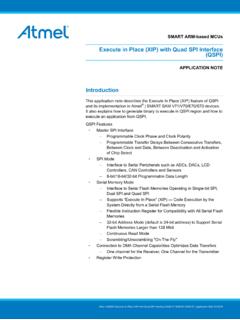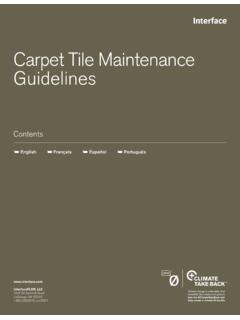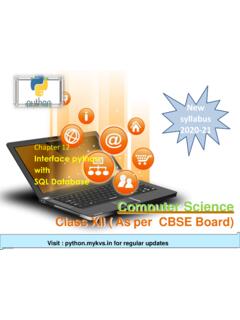Transcription of Everything you wanted to know about interfaces, but were …
1 Everything you wanted to know about interfaces, but were afraid to ask Louis S. Wheatcraft Requirements Experts Phone: (281) 486-9481 Mobile: (832) 971-3550. E-mail: Internet: Copyright 2010 by Requirements Experts. Abstract. Some of the biggest problems in developing a system are at an interface . Some of the most critical requirements for every system that we build are interface requirements. interface requirements cannot be written in a vacuum, both sides must participate. Yet how to write interface requirements is barely covered in the literature and what is in the literature is not consistent. This paper will address some things you can do to get better interface requirements. Topics covered include: Understand what constitutes an interface , how to identify interfaces, how to define and document interface definitions, what constitutes a good interface requirement, and where and how to document interface requirements.
2 Why are Interfaces Important? Systems are part of other systems, are made up of subsystems, and interact with other systems at the same level of the architecture, no matter what level your system of interest (SOI) is at. This applies to simple as well as complex systems, hardware systems, software systems, and hybrid hardware/software systems. These interactions between your system and others are interfaces. Identifying interfaces helps you to define your system's boundaries. Indentifying interfaces also helps you understand the dependencies your system has with other systems and dependencies other systems have with your system. Failing to identify an interface can have unpleasant repercussions on your project and is a common reason for products that fail to meet stakeholder expectations. Missing or incorrectly defined interfaces are often a major cause of cost overruns and product failures.
3 Indentifying interfaces helps you ensure compatibility between your system and other systems you need to interact with. Many projects neglect to identify and control their interfaces until testing. The first encounter with the results of this oversight often occurs when people find out that they cannot connect test equipment to their system to perform the tests. Worse yet, think of the problems when you turn your system over to operations and a missing interface is discovered such that your system can not function or another system depending on your system can't function. By identifying and managing your external interfaces early, you are identifying key drivers for your product that must be addressed in your system requirements. Identifying interfaces also helps to expose potential problem areas and risks to your project. There are often existing systems that you have to interface with that are established and cannot change.
4 This might be a problem for you it might not, but you need to know. There may be systems that you have to interface with that don't currently exist that are being developed in parallel with your 1 of 14 system. How can you develop requirements for your system when you don't know what your interfaces are or the characteristics of those interfaces? You need to know any issues associated with your interfaces early so that you can insure compatibility with existing systems or work with the other developing system to jointly define the interfaces so you are compatible. Serious problems can and do arise at interfaces due to the inherent risks associated with a system's interfaces. Because the interfaces represent systems outside your control, your system is vulnerable at your interfaces. If an interface is not well understood, not defined, or is subject to change, your system will be impacted.
5 There is also the treat of someone outside your system impacting your system's performance either intentionally or unintentionally. There is an old saying If you want to sabotage someone's system, do it at an interface .. Because of the importance of identifying, defining, developing interface requirements, and managing these activities, interfaces need to be a prime concern of the project System Engineer, lead Software Engineer, Business Analysis, or anyone else involved in developing requirements. Given the importance of interfaces, you would think that there is a standard process to indentify and define interfaces, to develop interface requirements, and manage these activities. Unfortunately there is not. Given the different cultures within industries and within organizations, each manages these activities differently. This results in a lot of confusion on where to document this information and even what to call these documents.
6 Regardless of the names we give various documents that contain information concerning interfaces, there are some guiding principles and best practices you can follow. These best practices are based on lessons learned as a result of being exposed to a variety of approaches to managing interface requirements and having seen what approaches work best and what approaches that tend to lead to problems. What Is An interface ? An interface is a boundary where, or across which, two or more parts interact. Another definition is: An interface is that design feature of a piece of equipment that affects or is affected by a design feature of another system. This interaction is shown in Figure 1. What is an interface ? A common functional or physical boundary where two systems interact. Mechanical attach point Voltage Data Command Sys 1 Media Sys 2.
7 interface Boundary 9. Figure 1: Definition of an interface 2 of 14 The key words here are interact and affects or is affected by another system . From a requirements standpoint, any time the wording of a requirement indicates or implies one of these conditions, there is an interface involved. If there is an interface involved, then the requirement dealing with this interface is classified as an interface requirement. It is also important to understand what an interface is not. Figure 2 shows examples of what an interface is not. Examples of misunderstanding what an interface is and is not The digital data interface shall maintain full operational capability after two failures. The interfaces between the spacecraft and payload shall be designed to . The interfaces between the spacecraft and payload shall have standard labels, controls, and displays.
8 The electrical interface between the spacecraft and payload shall have a reliability of .99999. 11. Figure 2: Examples of what an interface is NOT. Unfortunately, we frequently see statements like these. The first requirement assumes the interface is a system and has functionality this is not true. The second is a requirement on the designers and also assumes the interfaces are things. The requirement should be on accessibility of connectors, bolts, etc. The third and fourth again assumes the interface is a thing. These are requirements on each of the systems and apply to any hardware or software of the system involved in interfacing with another system. The bottom line: There should be no requirements that say . The interface shall .. Process to Write interface Requirements Writing interface requirements is a three-step process: Step 1: Identify the interfaces Step 2: Define the interfaces Step 3: Write the interface requirements.
9 Step 1: Identify the Interfaces This first step involves an analysis of the of your System of Interest (SOI) and the context in which it relates (interacts) with the parent system it is part of (external interfaces) and an analysis of the parts that make up your SOI and how they relate (interact) with each other (internal interfaces.). The tools that are often used as part of this analysis are Operation Concepts, System Block Diagrams, N-Squared (N2) diagrams, Allocation Analysis, External interface Block Diagrams (Context Diagrams), and interface Block Diagrams. The intent is to define your system's interfaces top down. Start with the Parent System Block Diagram, then develop an N2 diagram to 3 of 14 refine your knowledge of the interfaces between all elements that make up your parent system including the interfaces of your system.
10 Then using this knowledge along with the knowledge from your system's Operational Concepts, develop an External Block Diagram for your system showing all external interfaces of your SOI with all other systems for all lifecycles. Then for each system you interface with, you do an individual interface Block Diagram, showing all the interfaces between your SOI and that system. Once you have defined the architecture for your SOI, this approach is repeated at the next level to address your system's internal interfaces. Operational Concepts: Your system will have different interfaces at different times in its life cycle. All must be considered to make sure that nothing is overlooked. An effective way to identify interfaces is to develop Operational Concepts from different stakeholder viewpoints addressing each lifecycle stage. The stakeholders associated with each of the systems your System's interfaces with will have unique knowledge you need when identifying and defining interfaces and their associated interface requirements.






